TOYOTA RAV4 2006 Service Repair Manual
Manufacturer: TOYOTA, Model Year: 2006, Model line: RAV4, Model: TOYOTA RAV4 2006Pages: 2000, PDF Size: 45.84 MB
Page 1811 of 2000

EI–40ENGINE IMMOBILISER – ENGINE IMMOBILISER SYSTEM
EI
(a) Disconnect the E46 ECU connector.
(b) Disconnect the A9 ECM connector.
(c) Measure the resistance of the wire harness side
connectors.
Standard resistance
NG
OK
(a) Temporarily replace the transponder key ECU with a new
or normally functioning one.
(b) Check that then engine starts normally.
OK:
Engine starts normally.
NG
OK
2CHECK WIRE HARNESS (TRANSPONDER KEY ECU - ECM)
B129773E02
Tester Connection Specified Condition
E46-13 (EFIO) - A9-11 (IMI)
Below 1
E46-12 (EFII) - A9-10 (IMO)
E46-11 (EGND) - A9-9 (EOM)
E46-13 (EFIO) or A9-11 (IMI) - Body
ground
10 k
or higher
E46-12 (EFII) or A9-10 (IMO) - Body
ground
REPAIR OR REPLACE HARNESS AND
CONNECTOR
3CHECK TRANSPONDER KEY ECU (OPERATION)
REPLACE ECM
END (TRANSPONDER KEY ECU IS DEFECTIVE)
Page 1812 of 2000
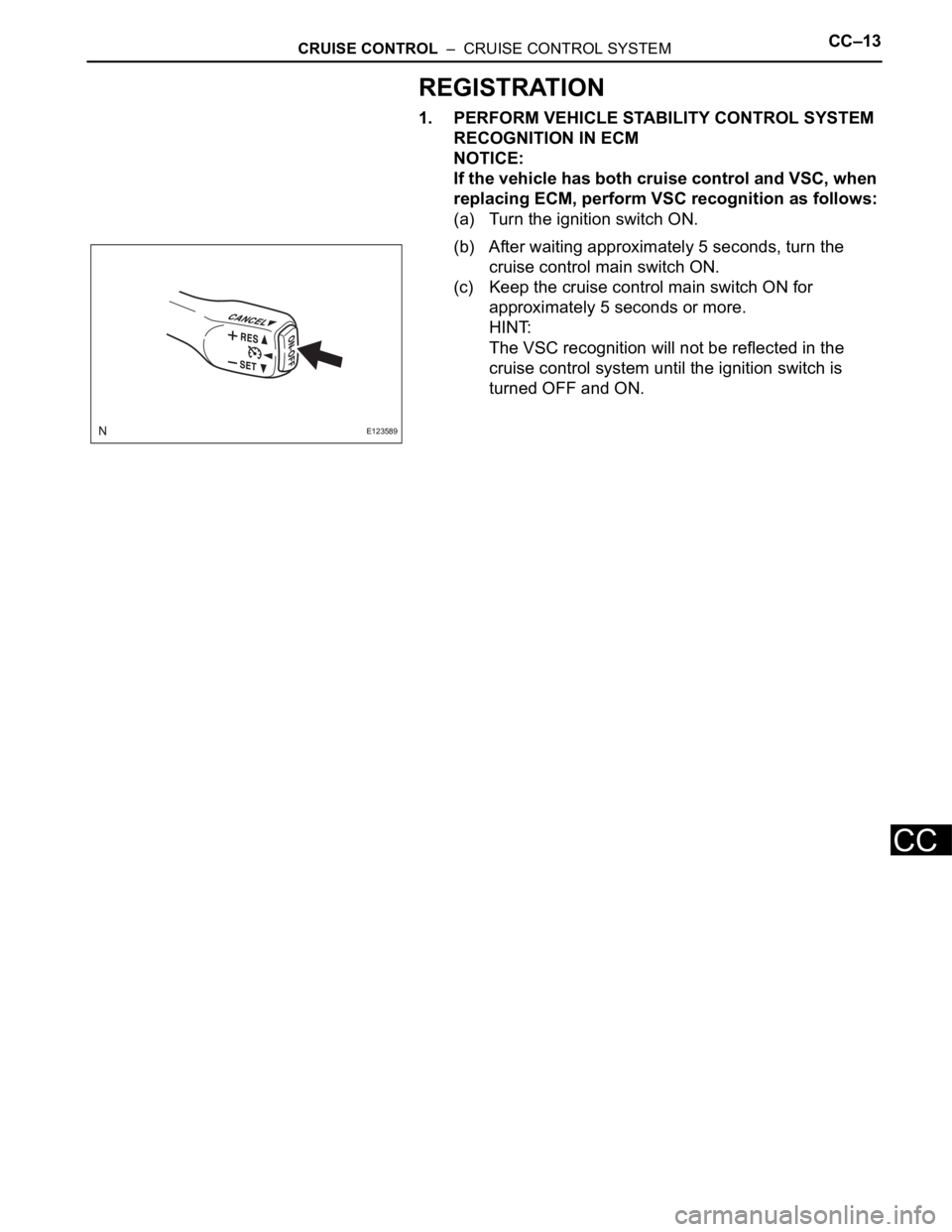
CRUISE CONTROL – CRUISE CONTROL SYSTEMCC–13
CC
REGISTRATION
1. PERFORM VEHICLE STABILITY CONTROL SYSTEM
RECOGNITION IN ECM
NOTICE:
If the vehicle has both cruise control and VSC, when
replacing ECM, perform VSC recognition as follows:
(a) Turn the ignition switch ON.
(b) After waiting approximately 5 seconds, turn the
cruise control main switch ON.
(c) Keep the cruise control main switch ON for
approximately 5 seconds or more.
HINT:
The VSC recognition will not be reflected in the
cruise control system until the ignition switch is
turned OFF and ON.
E123589
Page 1813 of 2000
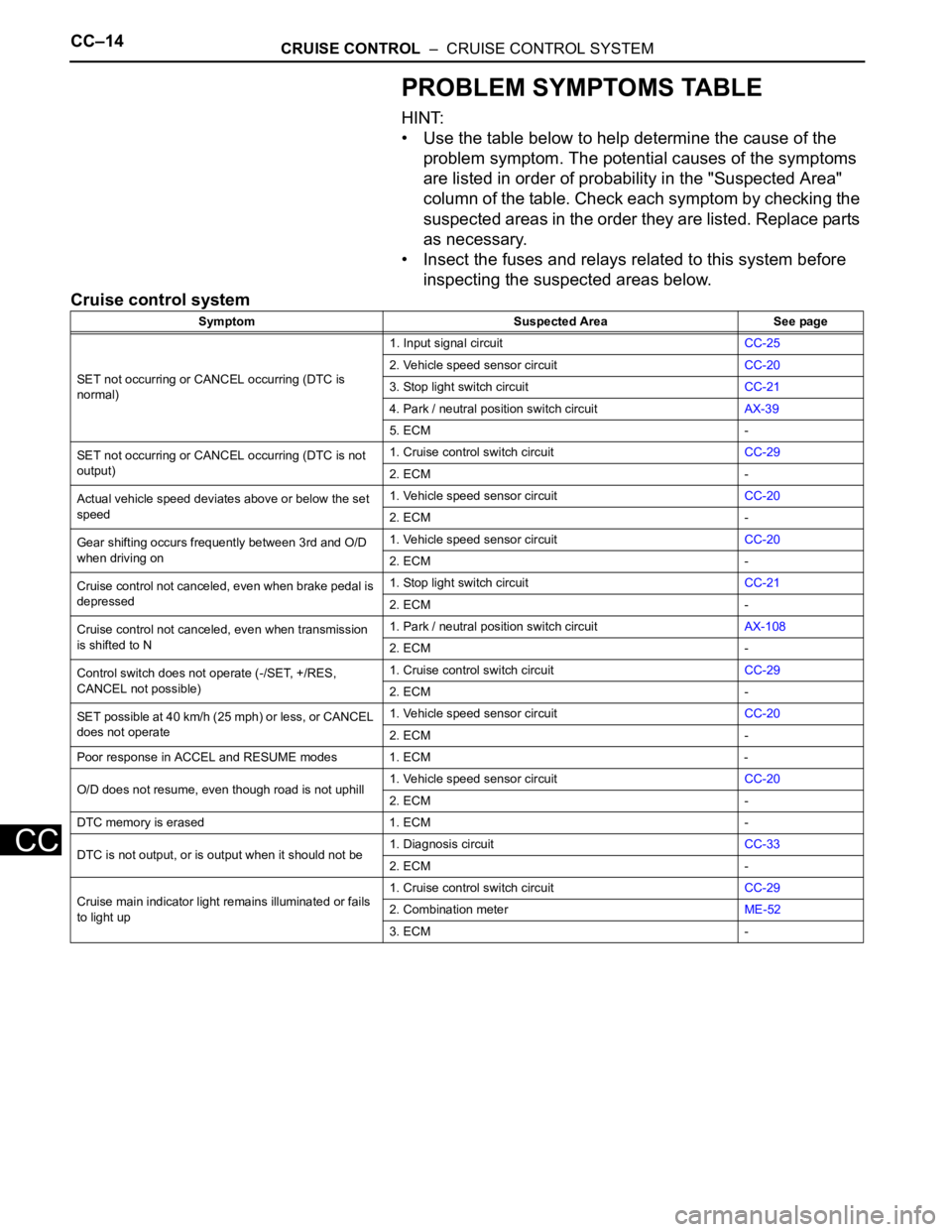
CC–14CRUISE CONTROL – CRUISE CONTROL SYSTEM
CC
PROBLEM SYMPTOMS TABLE
HINT:
• Use the table below to help determine the cause of the
problem symptom. The potential causes of the symptoms
are listed in order of probability in the "Suspected Area"
column of the table. Check each symptom by checking the
suspected areas in the order they are listed. Replace parts
as necessary.
• Insect the fuses and relays related to this system before
inspecting the suspected areas below.
Cruise control system
Symptom Suspected Area See page
SET not occurring or CANCEL occurring (DTC is
normal)1. Input signal circuitCC-25
2. Vehicle speed sensor circuitCC-20
3. Stop light switch circuitCC-21
4. Park / neutral position switch circuitAX-39
5. ECM -
SET not occurring or CANCEL occurring (DTC is not
output)1. Cruise control switch circuitCC-29
2. ECM -
Actual vehicle speed deviates above or below the set
speed1. Vehicle speed sensor circuitCC-20
2. ECM -
Gear shifting occurs frequently between 3rd and O/D
when driving on1. Vehicle speed sensor circuitCC-20
2. ECM -
Cruise control not canceled, even when brake pedal is
depressed1. Stop light switch circuitCC-21
2. ECM -
Cruise control not canceled, even when transmission
is shifted to N1. Park / neutral position switch circuitAX-108
2. ECM -
Control switch does not operate (-/SET, +/RES,
CANCEL not possible)1. Cruise control switch circuitCC-29
2. ECM -
SET possible at 40 km/h (25 mph) or less, or CANCEL
does not operate1. Vehicle speed sensor circuitCC-20
2. ECM -
Poor response in ACCEL and RESUME modes 1. ECM -
O/D does not resume, even though road is not uphill1. Vehicle speed sensor circuitCC-20
2. ECM -
DTC memory is erased 1. ECM -
DTC is not output, or is output when it should not be1. Diagnosis circuitCC-33
2. ECM -
Cruise main indicator light remains illuminated or fails
to light up1. Cruise control switch circuitCC-29
2. Combination meterME-52
3. ECM -
Page 1814 of 2000
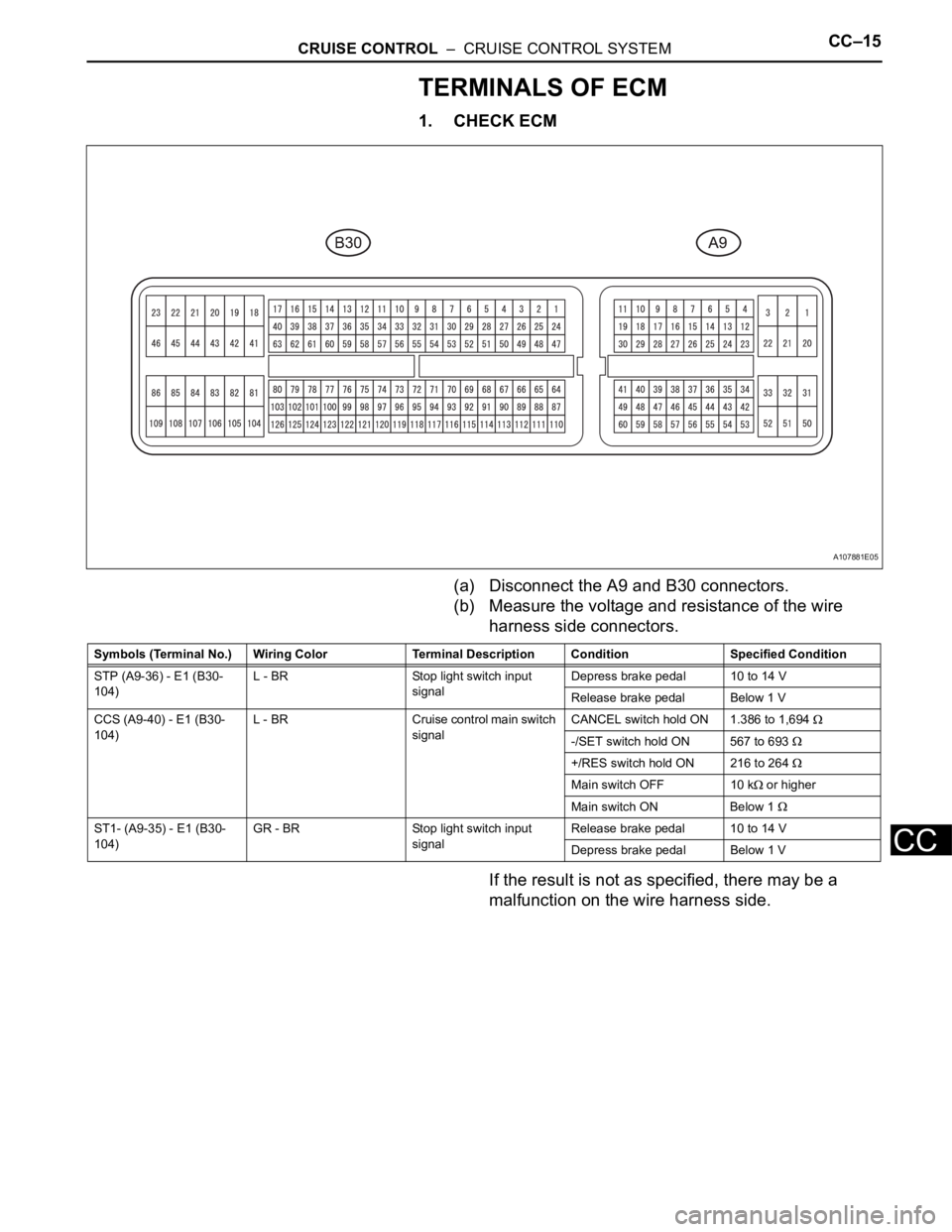
CRUISE CONTROL – CRUISE CONTROL SYSTEMCC–15
CC
TERMINALS OF ECM
1. CHECK ECM
(a) Disconnect the A9 and B30 connectors.
(b) Measure the voltage and resistance of the wire
harness side connectors.
If the result is not as specified, there may be a
malfunction on the wire harness side.
A107881E05
Symbols (Terminal No.) Wiring Color Terminal Description ConditionSpecified Condition
STP (A9-36) - E1 (B30-
104)L - BR Stop light switch input
signalDepress brake pedal 10 to 14 V
Release brake pedal Below 1 V
CCS (A9-40) - E1 (B30-
104)L - BR Cruise control main switch
signalCANCEL switch hold ON 1.386 to 1,694
-/SET switch hold ON 567 to 693
+/RES switch hold ON 216 to 264
Main switch OFF 10 k or higher
Main switch ON Below 1
ST1- (A9-35) - E1 (B30-
104)GR - BR Stop light switch input
signalRelease brake pedal 10 to 14 V
Depress brake pedal Below 1 V
Page 1815 of 2000
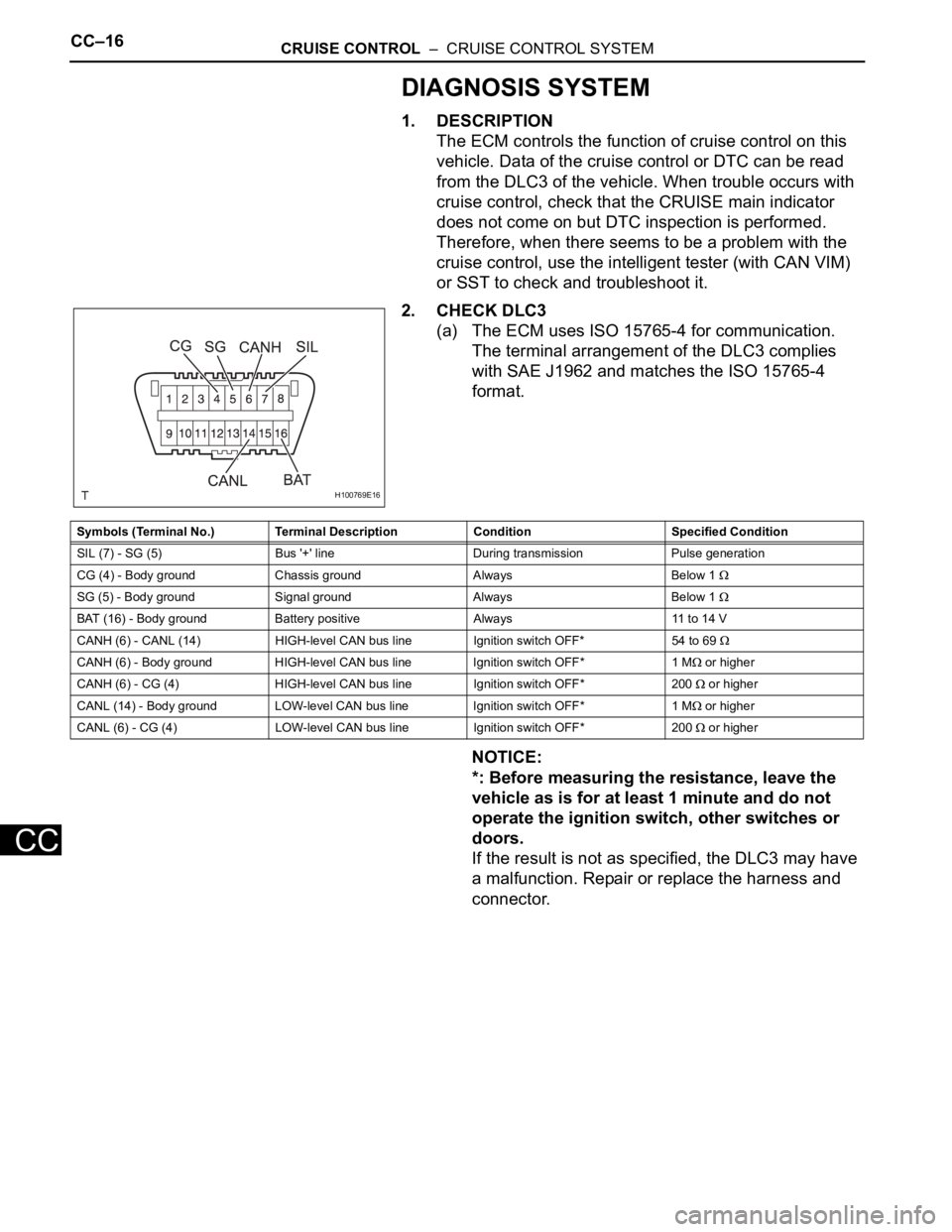
CC–16CRUISE CONTROL – CRUISE CONTROL SYSTEM
CC
DIAGNOSIS SYSTEM
1. DESCRIPTION
The ECM controls the function of cruise control on this
vehicle. Data of the cruise control or DTC can be read
from the DLC3 of the vehicle. When trouble occurs with
cruise control, check that the CRUISE main indicator
does not come on but DTC inspection is performed.
Therefore, when there seems to be a problem with the
cruise control, use the intelligent tester (with CAN VIM)
or SST to check and troubleshoot it.
2. CHECK DLC3
(a) The ECM uses ISO 15765-4 for communication.
The terminal arrangement of the DLC3 complies
with SAE J1962 and matches the ISO 15765-4
format.
NOTICE:
*: Before measuring the resistance, leave the
vehicle as is for at least 1 minute and do not
operate the ignition switch, other switches or
doors.
If the result is not as specified, the DLC3 may have
a malfunction. Repair or replace the harness and
connector.
H100769E16
Symbols (Terminal No.) Terminal Description Condition Specified Condition
SIL (7) - SG (5) Bus '+' line During transmission Pulse generation
CG (4) - Body ground Chassis ground Always Below 1
SG (5) - Body ground Signal ground Always Below 1
BAT (16) - Body ground Battery positive Always 11 to 14 V
CANH (6) - CANL (14) HIGH-level CAN bus line Ignition switch OFF*54 to 69
CANH (6) - Body ground HIGH-level CAN bus line Ignition switch OFF* 1 M or higher
CANH (6) - CG (4) HIGH-level CAN bus line Ignition switch OFF* 200
or higher
CANL (14) - Body ground LOW-level CAN bus line Ignition switch OFF* 1 M
or higher
CANL (6) - CG (4) LOW-level CAN bus line Ignition switch OFF* 200
or higher
Page 1816 of 2000
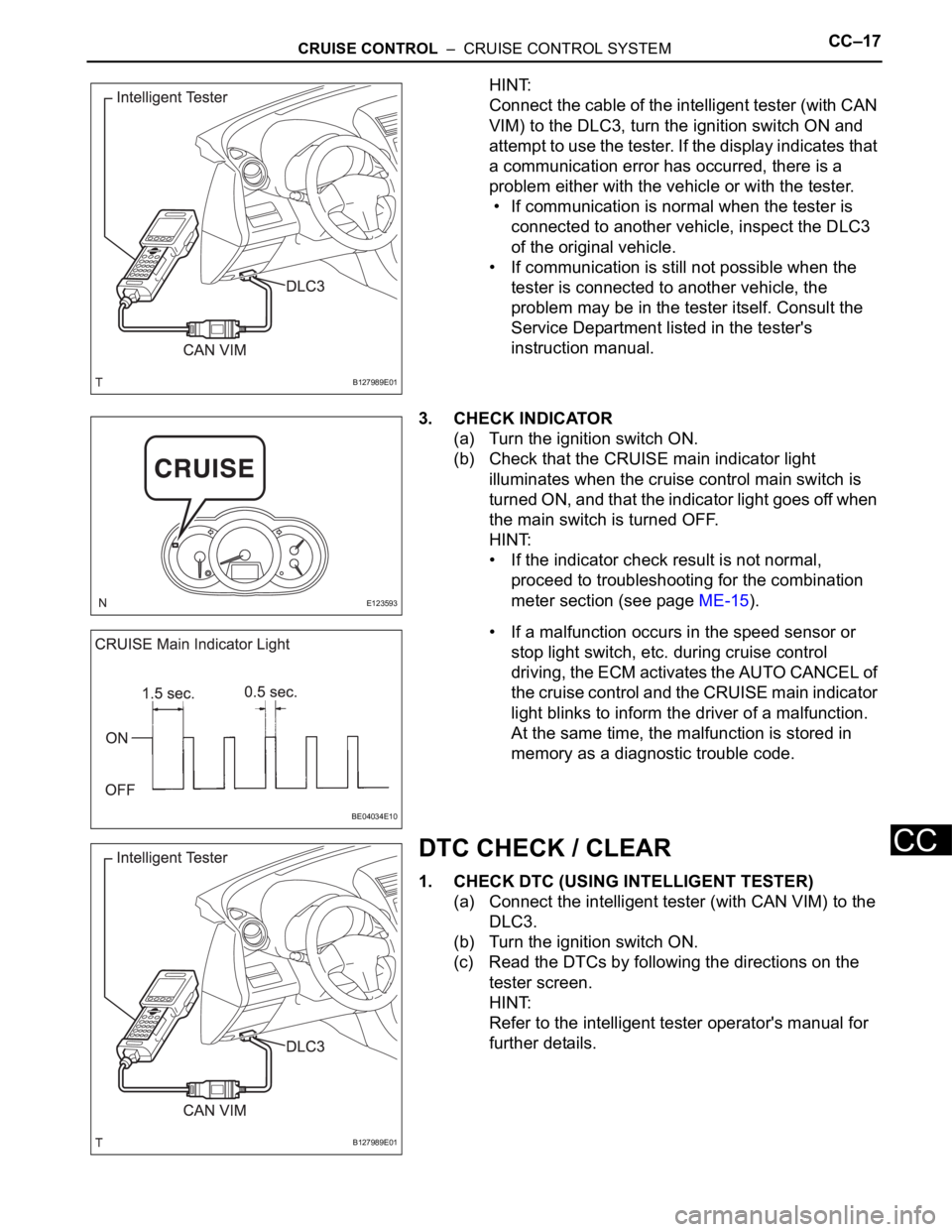
CRUISE CONTROL – CRUISE CONTROL SYSTEMCC–17
CC
HINT:
Connect the cable of the intelligent tester (with CAN
VIM) to the DLC3, turn the ignition switch ON and
attempt to use the tester. If the display indicates that
a communication error has occurred, there is a
problem either with the vehicle or with the tester.
• If communication is normal when the tester is
connected to another vehicle, inspect the DLC3
of the original vehicle.
• If communication is still not possible when the
tester is connected to another vehicle, the
problem may be in the tester itself. Consult the
Service Department listed in the tester's
instruction manual.
3. CHECK INDICATOR
(a) Turn the ignition switch ON.
(b) Check that the CRUISE main indicator light
illuminates when the cruise control main switch is
turned ON, and that the indicator light goes off when
the main switch is turned OFF.
HINT:
• If the indicator check result is not normal,
proceed to troubleshooting for the combination
meter section (see page ME-15).
• If a malfunction occurs in the speed sensor or
stop light switch, etc. during cruise control
driving, the ECM activates the AUTO CANCEL of
the cruise control and the CRUISE main indicator
light blinks to inform the driver of a malfunction.
At the same time, the malfunction is stored in
memory as a diagnostic trouble code.
DTC CHECK / CLEAR
1. CHECK DTC (USING INTELLIGENT TESTER)
(a) Connect the intelligent tester (with CAN VIM) to the
DLC3.
(b) Turn the ignition switch ON.
(c) Read the DTCs by following the directions on the
tester screen.
HINT:
Refer to the intelligent tester operator's manual for
further details.
B127989E01
E123593
BE04034E10
B127989E01
Page 1817 of 2000
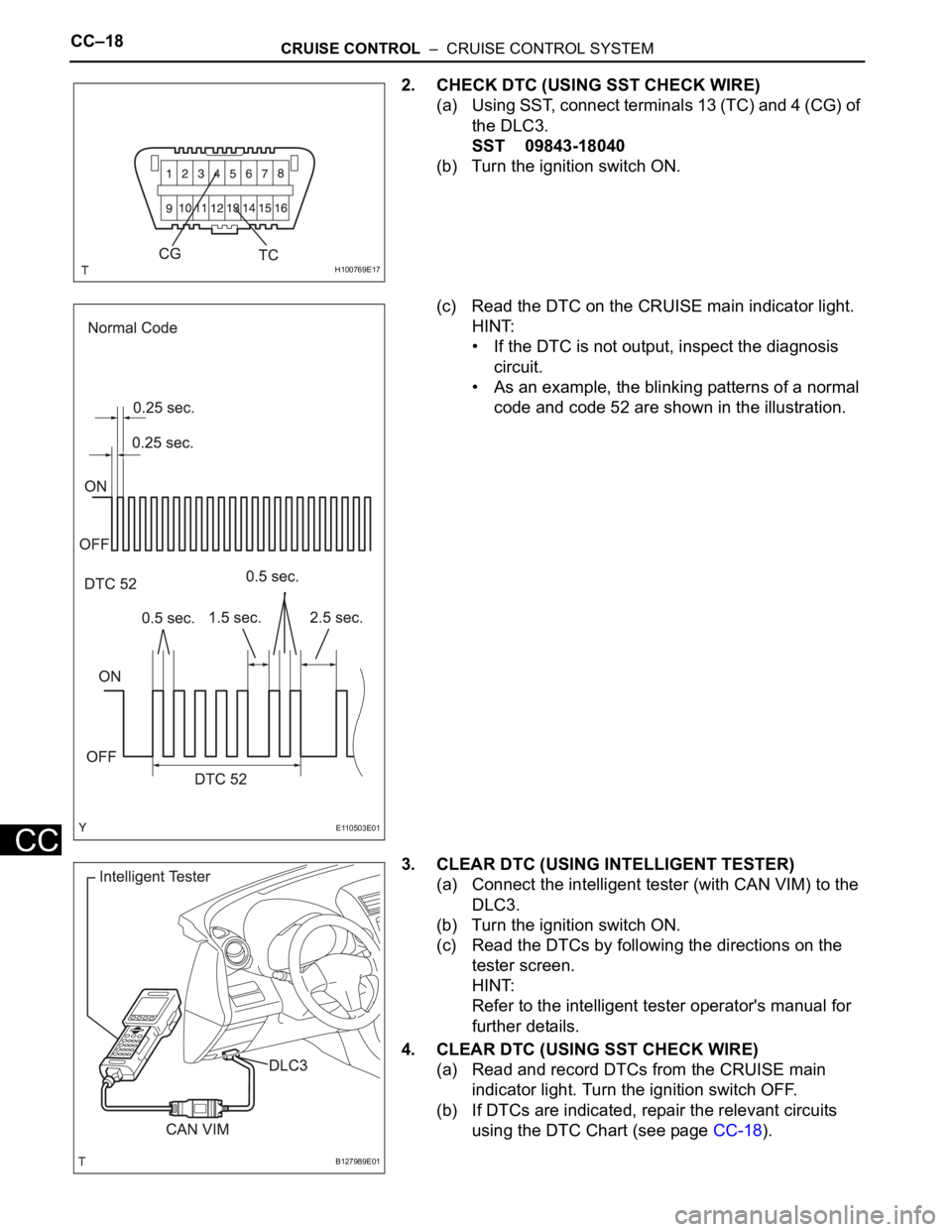
CC–18CRUISE CONTROL – CRUISE CONTROL SYSTEM
CC
2. CHECK DTC (USING SST CHECK WIRE)
(a) Using SST, connect terminals 13 (TC) and 4 (CG) of
the DLC3.
SST 09843-18040
(b) Turn the ignition switch ON.
(c) Read the DTC on the CRUISE main indicator light.
HINT:
• If the DTC is not output, inspect the diagnosis
circuit.
• As an example, the blinking patterns of a normal
code and code 52 are shown in the illustration.
3. CLEAR DTC (USING INTELLIGENT TESTER)
(a) Connect the intelligent tester (with CAN VIM) to the
DLC3.
(b) Turn the ignition switch ON.
(c) Read the DTCs by following the directions on the
tester screen.
HINT:
Refer to the intelligent tester operator's manual for
further details.
4. CLEAR DTC (USING SST CHECK WIRE)
(a) Read and record DTCs from the CRUISE main
indicator light. Turn the ignition switch OFF.
(b) If DTCs are indicated, repair the relevant circuits
using the DTC Chart (see page CC-18).
H100769E17
E110503E01
B127989E01
Page 1818 of 2000

CRUISE CONTROL – CRUISE CONTROL SYSTEMCC–19
CC
(c) Clear the DTCs according to one of the following
procedures.
• Disconnect the negative (-) battery cable for
more than 1 minute.
• Remove the EFI NO. 1 and ETCS fuses from the
engine room relay block (located inside the
engine compartment) for more than 1 minute.
(d) Recheck for DTCs.
Page 1819 of 2000

CC–20CRUISE CONTROL – CRUISE CONTROL SYSTEM
CC
FAIL-SAFE CHART
HINT:
If the following conditions are detected while the cruise
control is in operation, the system clears the stored vehicle
speed in the ECM and cancels the cruise control operation.
Cruise control system
HINT:
*: w/ VSC
Vehicle Condition Auto Cancel Condition Fail-safe Deactivation Condition
CRUISE main indicator light blinks• There is open or short in stop light switch
circuit
• There is problem with vehicle speed
signal
• There is problem with throttle position
sensor and motor
• VSC is damaged*
• There is communication malfunction
between VSC and ECM*Turn cruise control main switch ON again
CRUISE main indicator light blinks• There is problem with input circuit of stop
light switch circuit
• There is problem with cancel circuitTurn ignition switch ON
Page 1820 of 2000

CRUISE CONTROL – CRUISE CONTROL SYSTEMCC–21
CC
DATA LIST / ACTIVE TEST
1. READ DATA LIST
HINT:
Using the intelligent tester's DATA LIST allows switch,
sensor, actuator and other item values to be read without
removing any parts. Reading the DATA LIST early in
troubleshooting is one way to save time.
(a) Connect the intelligent tester (with CAN VIM) to the
DLC3.
(b) Turn the ignition switch ON.
(c) Read the DATA LIST according to the display on the
tester.
ECM
Item Measurement Item / Display
(Range)Normal Condition Diagnostic Note
VEHICLE SPD Vehicle speed / min.: 0 km/h (0
mph) max.: 200 km/h (125 mph)Actual vehicle speed -
MEMORY SPD Vehicle speed / min.: 0 km/h (0
mph) max.: 200 km/h (125 mph)Actual vehicle speed stored in
memory-
THROTTLE Throttle operating angle / min.: 0
deg. max.: 125 deg.Actual demanded throttle angle -
CRUISE CONTROL Cruise control / ON or OFF ON: Cruise control is SET
OFF: Cruise control is UNSET-
MAIN SW (MAIN) Main switch (Main CPU) / ON or
OFFON: Main switch (Main CPU) is
SET
OFF: Main switch (Main CPU) is
UNSET-
CCS READY M Switch ready (Main CPU) / ON or
OFFON: Switch ready (Main CPU) is
SET
OFF: Switch ready (Main CPU) is
UNSET-
CCS INDICATOR M Switch indicator (Main CPU) / ON
or OFFON: Switch indicator (Main CPU)
is SET
OFF: Switch indicator (Main
CPU) is UNSET-
CANCEL SW CANCEL switch / ON or OFF ON: CANCEL switch is SET
OFF: CANCEL switch is UNSET-
SET/COAST SW - / SET switch / ON or OFF ON: - / SET switch is SET
OFF: - / SET switch is UNSET-
RES/ACC SW + / RES switch / ON or OFF ON: + / RES switch is SET
OFF: + / RES switch is UNSET-
STP LIGHT SW M Stop light switch signal (Main
CPU) / ON or OFFON: Brake pedal depressed
OFF: Brake pedal released-
SHIFT D POS Shift D position / ON or OFF ON: Shift is D or 3 position
OFF: Shift is except D or 3
position-